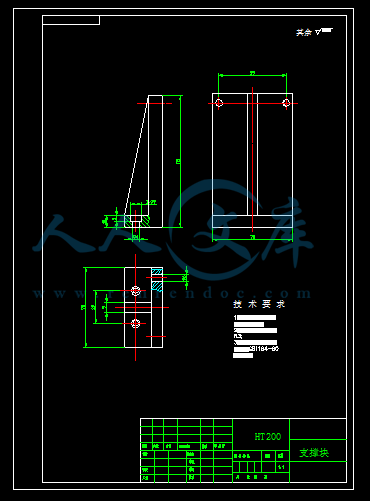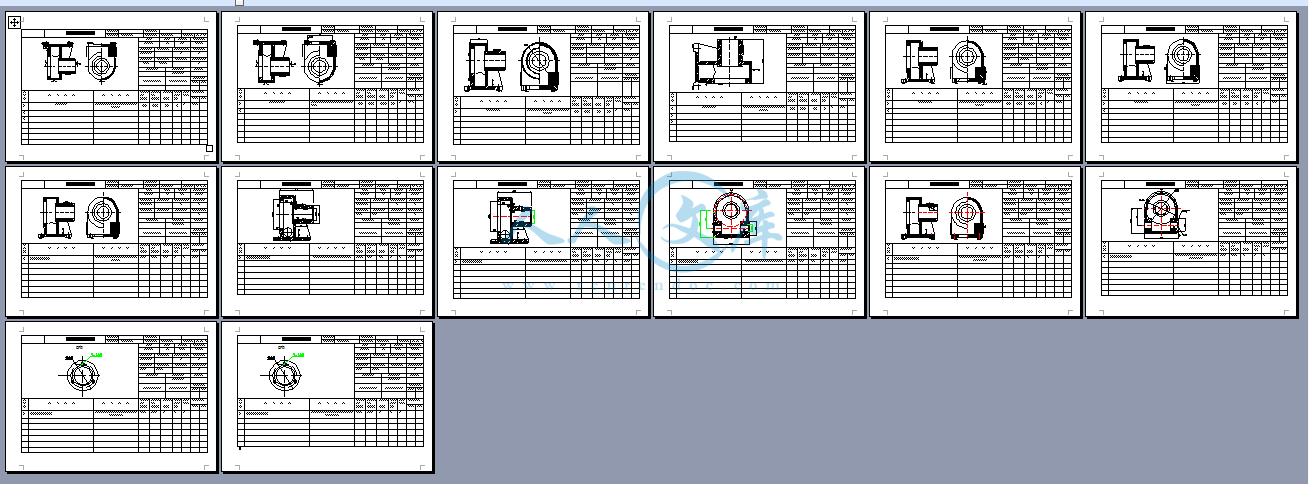摘 要
本设计是基于蜗轮箱体零件的加工工艺规程及一些工序的专用夹具设计。蜗轮箱体零件的主要加工表面是平面及孔系。一般来说,保证平面的加工精度要比保证孔系的加工精度容易。因此,本设计遵循先面后孔的原则。并将孔与平面的加工明确划分成粗加工和精加工阶段以保证孔系加工精度。基准选择以蜗轮箱体的输入轴和输出轴的支承孔作为粗基准,以顶面与两个工艺孔作为精基准。主要加工工序安排是先以支承孔系定位加工出顶平面,再以顶平面与支承孔系定位加工出工艺孔。在后续工序中除个别工序外均用顶平面和工艺孔定位加工其他孔系与平面。支承孔系的加工采用的是坐标法镗孔。整个加工过程均选用组合机床。夹具选用专用夹具,夹紧方式多选用气动夹紧,夹紧可靠,机构可以不必自锁,因此生产效率较高,适用于大批量、流水线上加工,能够满足设计要求。
关键词:蜗轮箱体类零件;工艺;夹具;
Abstract
The design is based on the body parts of the processing order of the processes and some special fixture design. Body parts of the main plane of the surface and pore system. In general, the plane guarantee processing precision than that of holes machining precision easy. Therefore, this design follows the surface after the first hole principle. Plane with holes and the processing clearly divided into roughing and finishing stages of holes to ensure machining accuracy. Datum selection box input shaft and the output shaft of the supporting hole as a rough benchmark, with top with two holes as a precision technology reference. Main processes arrangements to support holes for positioning and processing the top plane, and then the top plane and the supporting hole location hole processing technology. In addition to the follow-up processes individual processes are made of the top plane and technological hole location hole and plane processing. Supported hole processing using the method of coordinate boring. The whole process of processing machine combinations were selected. Selection of special fixture fixture, clamping means more choice of pneumatic clamping, clamping reliable, institutions can not be locked, so the production efficiency is high, suitable for large batch, line processing, can meet the design requirements.
Key words: box type parts process; fixture;
目 录
摘 要II
AbstractIII
第1章 绪论1
1.1 机械加工工艺概述1
1.2机械加工工艺流程1
1.3夹具概述2
1.4机床夹具的功能2
1.5机床夹具的发展趋势2
1.5.1机床夹具的现状2
1.5.2现代机床夹具的发展方向3
第2章 加工工艺规程设计5
2.1 零件的分析5
2.1.1 零件的作用5
2.1.2 零件的工艺分析5
2.2 蜗轮箱体加工的主要问题和工艺过程设计所应采取的相应措施5
2.2.1 孔和平面的加工顺序5
2.2.2 孔系加工方案选择6
2.3 蜗轮箱体加工定位基准的选择6
2.3.1 粗基准的选择6
2.3.2 精基准的选择6
2.4 蜗轮箱体加工主要工序安排7
2.5 机械加工余量、工序尺寸及毛坯尺寸的确定9
2.6确定切削用量及基本工时(机动时间)[3]10
2.7 时间定额计算及生产安排16
第3章 镗孔夹具设计21
3.1 研究原始质料21
3.2 定位、夹紧方案的选择21
3.3切削力及夹紧力的计算21
3.4 误差分析与计算22
3.5 零、部件的设计与选用23
3.5.1定位销选用23
3.5.2夹紧装置的选用24
3.6 夹具设计及操作的简要说明24
第4章 铣底面夹具设计25
4.1 机床夹具概述25
4.2研究原始质料26
4.3定位基准的选择26
4.4 切削力及夹紧分析计算26
4.5 误差分析与计算29
4.6 零、部件的设计与选用29
4.7 夹具操作步骤分析和可靠性预测30
总结31
参 考 文 献32
致 谢33
第1章 绪论
1.1 机械加工工艺概述
机械加工工艺是指用机械加工的方法改变毛坯的形状、尺寸、相对位置和性质使其成为合格零件的全过程,加工工艺是工人进行加工的一个依据。
机械加工工艺流程是工件或者零件制造加工的步骤,采用机械加工的方法,直接改变毛坯的形状、尺寸和表面质量等,使其成为零件的过程称为机械加工工艺过程。比如一个普通零件的加工工艺流程是粗加工-精加工-装配-检验-包装,就是个加工的笼统的流程。
机械加工工艺就是在流程的基础上,改变生产对象的形状、尺寸、相对位置和性质等,使其成为成品 或半成品,是每个步骤,每个流程的详细说明,比如,上面说的,粗加工可能包括毛坯制造,打磨等等,精加工可能分为车,钳工,铣床,等等,每个步骤就要有详 细的数据了,比如粗糙度要达到多少,公差要达到多少。
技术人员根据产品数量、设备条件和工人素质等情况,确定采用的工艺过程,并将有关内容写成工艺文件,这种文件就称工艺规程。这个就比较有针对性了。每个厂都可能不太一样,因为实际情况都不一样。
总的来说,工艺流程是纲领,加工工艺是每个步骤的详细参数,工艺规程是某个厂根据实际情况编写的特定的加工工艺。














 川公网安备: 51019002004831号
川公网安备: 51019002004831号